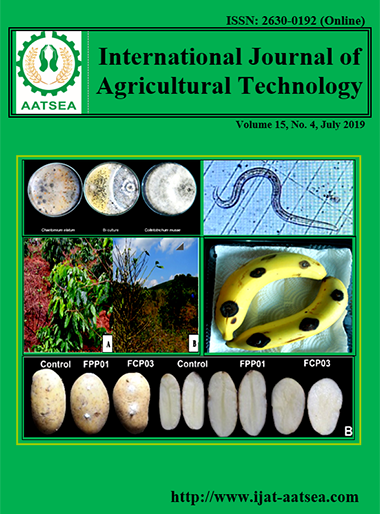Trends and challenges in organic farming in the European Union
Main Article Content
Abstract
Organic agriculture is a production and management system which takes into account the biodiversity, biological cycles, and increased biological activity of soil. Water balance in soil is one of the key factors in organic farming. Currently, organic farming is globally becoming more and more important because of people´s environmental and health concerns. Economic reasons are the strongest motivators of farmers for converting from conventional to organic production, however; the savings coming from lower farming costs. In the European Union (EU), the organic farming area is increasing by about 500,000 ha per year representing now about 6.2% of the total agricultural area. The variation in different countries is high inside EU due to various factors. The best agricultural practices are deployed in organic farming helping farmers to adapt to climate change by strengthening agro-ecosystems, improving soil structure, water management, and water quality, diversifying crop and livestock production, while concomitantly building farmers’ knowledge base.
Article Details

This work is licensed under a Creative Commons Attribution-NonCommercial-NoDerivatives 4.0 International License.
References
Berg, H., Maneas, G., Salguero Engström, A., Berg, H., Maneas, G. and Salguero Engström, A. (2018). A Comparison between Organic and Conventional Olive Farming in Messenia, Greece. Horticulturae, 4:15.
Borell, E. Von. and Sbrensen, J. T. (2004). Organic livestock production in Europe: aims, rules and trends with special emphasis on animal health and welfare. Livestock Production Science, 90:3-9.
Brzezina, N., Biely, K., Helfgott, A., Kopainsky, B., Vervoort, J. and Mathijs, E. (2017). Development of organic farming in Europe at the crossroads: Looking for the way forward through system archetype lenses. Sustainability, 9:821.
Crowder, D. W. and Reganold, J. P. (2015). Financial competitiveness of organic agriculture on a global scale. PNAS, 112:7611-7616.
Economic and Financial Affairs Council (Ecofin) (2018). Eurogroup meeting / Informal meeting of economic and financial affairs ministers.
EU science hub (2015). Best practices in improving the sustainability of agriculture. Retrieved from https://ec.europa.eu/jrc/en/event/conference/best-practices-improving-sustainability-agriculture.
European Commission (2016). Facts and figures on organic agriculture in the European Union. Agriculture and Rural Development, European Union, pp.47.
European statistics (2017). Organic farming statistics-Statistics Explained. Retrieved from http://ec.europa.eu/eurostat/statistics-explained/index.php/Organic_farming_statistics. [Accessed: 09-Oct-2018].
FAO (1999). Organic Agriculture. Fifteen Session of the Committee on Agriculture. Retrieved from http://www.fao.org/docrep/meeting/x0075e.htm [Accessed: 23-Sep-2018].
Gomiero, T. Pimentel, D. and Paoletti, M. G. (2011). Environmental impact of different agricultural management practices: Conventional vs. Organic agriculture,” CRC. Critical Reviews in Plant Sciences, 30:95-124.
Himilä, E. (2016). Organic farming in Finland by 2020. Analysis and review of consumer behaviour and demand for organic food products in Finland. (Bachelo Thesis). Metropolia University of Applied Sciences, Finland.
IFOAM (2018). Organic Agriculture & Healthy Soils. Retrieved from https://www.ifoam.bio/sites/default/files/oa_and_soils_web.pdf.
Jensen, E. S., Bedoussac, L., Carlsson, G., Journet, E. P., Justes, E. and Hauggaard-Nielsen, H. (2015). Enhancing Yields in Organic Crop Production by Eco-Functional Intensification. Sustainable Agriculture Research 4:42.
Lammerts van Buerenab, E. T., Jonesc, S. S., Tammd, L., Murphyc, K. M., Myerse, J. R., Leifertf, C. and Messmer, M. M. (2011). The need to breed crop varieties suitable for organic farming, using wheat, tomato and broccoli as examples: A review. NJAS – Wageningen Journal of Life Sciences, 58:193-205.
Lernoud, J. and Willer, H. (2018). Organic Agriculture Worldwide 2016: Current Statistics. The World of Organic Agriculture 2018 www.organic-world.net.
Levidow, L. and Bijman, J. (2002). Farm inputs under pressure from the European food industry. Food Policy, 27:31-45.
Meredith, S. and Willer, H. (2016). Organic In Europe: Prospects and Developments 2016. IFOAM EU and FiBL, ISBN: 978-3-03736-313-3, pp.88.
Ministry of Agriculture and Forestry (2014). Organics in Finland 2013. Retrieved from https://proluomu.fi/wp-content/uploads/sites/3/2015/01/Organics-in-Finland-2013.pdf.
Morison, J., Hine, R. and Pretty, J. (2005). Survey and Analysis of Labour on Organic Farms in the UK and Republic of Ireland. International Journal of Agricultural Sustainability, 3:24-43.
MTK (2017). Agriculture in Finland. Retrieved from https://www.mtk.fi/MTK_english/Agriculture_in_Finland/en_GB/Agriculture_in_Finland/. [Accessed: 01-Oct-2018].
Niemi, J. and Väre, M. (2017). Finnish agriculture and food sector 2016/17. Retrieved from https://jukuri.luke.fi/bitstream/handle/10024/540352/luke-luobio_49_2017.pdf?sequence =5&is Allowed=y.
Niggli, U., Schmidt, J., Watson, C., Kriipsalu, M., Shanskiy, M., Bàrberi, P., Kowalska, J., Schmitt, A., Daniel, C., Wenthe, U., Conder, M., Wohlfahrt, J., Schild, M., Dierauer, H., Krauss, M., Moeskops, B., Padel, S., Micheloni, C., Constanzo, A., Thonar, C. and Wilbois, K-P. (2016). Organic knowledge network arable. State-of-the-art research results and best practices. Report D.3.1. http://www.ok-neable.eu/images/OK_Net_WP3_D3.1_final.pdf.
Nikolic, S. R., Vukovic, P. and Grujic, B. (2017). Measures to support the development of organic farming in the EU and Serbia. Economics of Agricultural, 64:323-337.
Paul, K., Acram, T. and John, R. (2006). Organic Agriculture: A Global Perspective. CSIRO Publishing, Australia, pp.480.
Preissel, S. Reckling, M. Schläfke, N. and Zander, P. (2015). Magnitude and farm-economic value of grain legume pre-crop benefits in Europe: A review. Field Crops Research, 175:64-79.
Röös, E., Mie, A.,Wivstad, M., Salomon, E., Johansson, B. B. K., Gunnarsson, S., Wallenbeck, A., Hoffmann, R., Nilsson, Ulf J., Sundberg, C. and Watson, C. A. (2018). Risks and opportunities of increasing yields in organic farming. A review. Agronomy for Sustainable Development, 38:14.
Ruralia-institute (2018). Economic impact of organic production in Finland over EUR 680 million. University of Helsinki. Retrieved from https://www.helsinki.fi/en/news/society-economy/economic-impact-of-organic-production-in-finland-over-eur-680-million. [Accessed: 22-Sep-2018].
Smith-Spangler, C., Brandeau, ML., Hunter, G. E., Bavinger, J. C., Pearson, M., Eschbach, P. J., Sundaram, V., Liu, H., Schirmer, P., Stave, C., Olkin, I. and Bravata, D. M. (2012). Are organic foods safer or healthier than conventional alternatives?: A systematic review. Annals of Internal Medicine, 157:348-366.
Tuck, S. L., Winqvist, C., Mota, F., Ahnström, J., Turnbull, L. A. and Bengtsson, J. (2014). Land-use intensity and the effects of organic farming on biodiversity: A hierarchical meta-analysis. Journal of Applied Ecology, 51:746-755.
Viitaharju, L., Kujala, S. and Törmä, H. (2017). Economic Effects of Organic Production in Finland. NJF Seminar 495, The 4th Organic Conference, Mikkeli, Finland, pp.145.
Willer, H. and Lernoud, J. (2018). The World of organic agriculture STATISTICS & EMERGING TRENDS 2018. Research Institute of Organic Agriculture FiBL. 348 pp.


